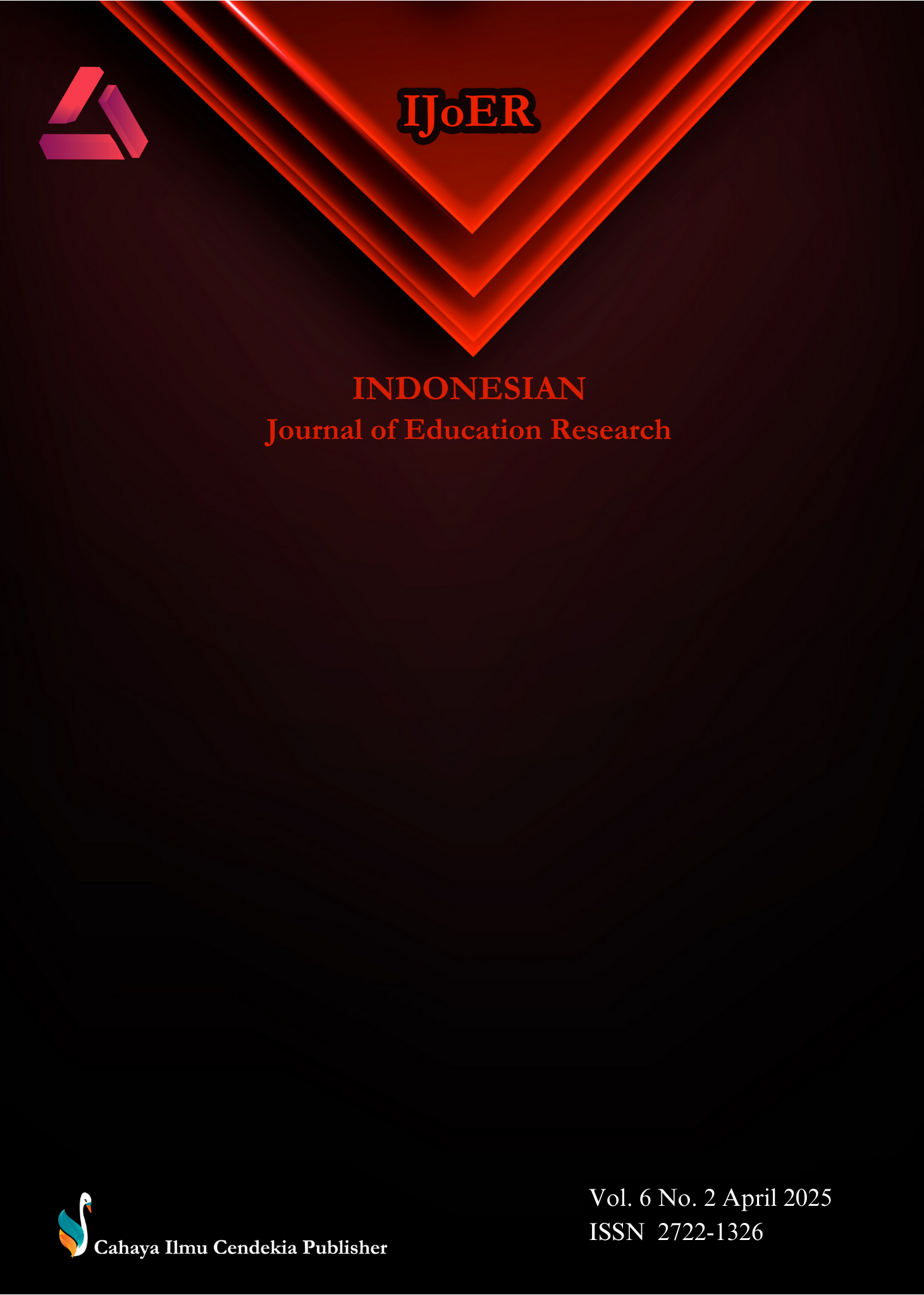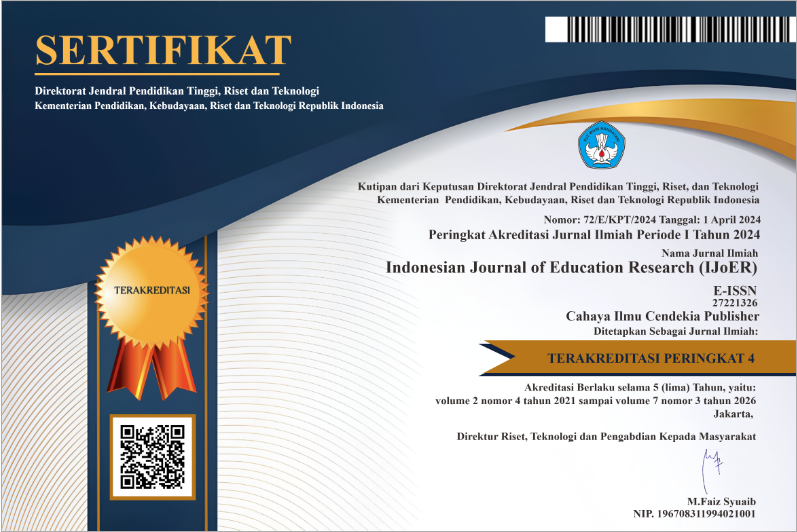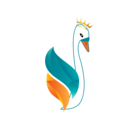Composing Poetry from Rhythm: The Influence of Song Media on the Writing Skills of Grade X Students
Abstract
Purpose of the study: This study aims to determine the ability to write poetry with the theme of mother by utilizing songs.
Methodology: The research methodology used is a qualitative descriptive method. Data collection techniques in this study consist of several things, including observation, tests, interviews, and documentation. There are three components used in the analysis, namely, the suitability of the contents of the poem to the theme, the accuracy of word choice (diction), and the use of language style (figure of speech).
Main Findings: The results of the study showed that the ability to write poetry of class X students by utilizing song media was classified as good, with an average overall score reaching 81.83%, which was included in the Good category. A total of 13 students (65%) were qualified as good, 6 students (30%) were qualified as sufficient, and 1 student (5%) was in the qualification that must be maximized, while no students achieved the qualification of very good. The use of songs as a learning medium has proven effective in improving the ability to write poetry, especially in terms of theme and language style, although in terms of diction there are still quite striking variations between participants.
Novelty/Originality of this study: This study offers novelty by combining visual and auditory approaches in learning to write poetry. Students will use songs as a stimulus to enrich diction and emotional expression, so that learning becomes more systematic, creative, and effective.
References
A. Kangasharju, L. Ilomäki, M. Lakkala, and A. Toom, “Lower secondary students’ poetry writing with the AI-based Poetry Machine,” Comput. Educ. Artif. Intell., vol. 3, no. May 2021, 2022, doi: 10.1016/j.caeai.2022.100048.
P. N. Johnson-Laird and K. Oatley, “How poetry evokes emotions,” Acta Psychol. (Amst)., vol. 224, p. 103506, 2022, doi: 10.1016/j.actpsy.2022.103506.
J. Segura and F. Sekulova, “Inner Mongolian poetry and song as a form of resistance,” Polit. Geogr., vol. 115, no. September 2023, p. 103214, 2024, doi: 10.1016/j.polgeo.2024.103214.
J. Holopainen and J. Ihanus, “Reflective writing about breast cancer experiences as part of an interactive poetry therapy group process,” Arts Psychother., vol. 90, no. January, 2024, doi: 10.1016/j.aip.2024.102194.
N. Köbis and L. D. Mossink, “Artificial intelligence versus Maya Angelou: Experimental evidence that people cannot differentiate AI-generated from human-written poetry,” Comput. Human Behav., vol. 114, no. September 2020, 2021, doi: 10.1016/j.chb.2020.106553.
E. Andina-Díaz, J. Siles-González, A. I. Gutiérrez-García, and Mc. C. Solano-Ruiz, “Perception of care from the perspective of nursing students: A study using photovoice, storytelling and poetry,” Nurse Educ. Pract., vol. 72, no. September, 2023, doi: 10.1016/j.nepr.2023.103791.
M. E. Davis, “Poetry and economics: Creativity, engagement and learning in the economics classroom,” Int. Rev. Econ. Educ., vol. 30, no. January, p. 100155, 2019, doi: 10.1016/j.iree.2019.100155.
D. Paiva, “Poetry as a resonant method for multi-sensory research,” Emot. Sp. Soc., vol. 34, no. October 2019, p. 100655, 2020, doi: 10.1016/j.emospa.2020.100655.
S. G. Bybee, J. Eaton, and B. Wong, “Dissemination innovation: Using found poetry to return study results to patients and partners facing cancer,” PEC Innov., vol. 4, no. April, p. 100286, 2024, doi: 10.1016/j.pecinn.2024.100286.
J. F. Ruma, S. Akter, J. J. Laboni, and R. M. Rahman, “A deep learning classification model for Persian Hafez poetry based on the poet’s era,” Decis. Anal. J., vol. 4, no. August, p. 100111, 2022, doi: 10.1016/j.dajour.2022.100111.
A. Duarte, Music, the Avant-Garde, and Counterculture Invisible Republics. Lisbon: the registered company Springer Nature Switzerland AG, 2024. doi: 10.1007/978-3-031-69514-8.
M. Meyer, Iconographic Research Poetry in the Classroom. Indiana: Springer, 2024. doi: 10.1007/978-981-97-2375-1_4.
S. Alharthi, “From instructed writing to free-writing: A study of EFL learners,” SAGE Open, vol. 11, no. 1, 2021, doi: 10.1177/21582440211007112.
A. M. A. Alzoubi, M. F. Mohammad, I. S. Albursan, S. F. A. Bakhiet, and A. A. Alfnan, “The predictive ability of emotional creativity in creative performance among university students,” SAGE Open, vol. 11, no. 2, 2021, doi: 10.1177/21582440211008876.
A. A. Bin Towairesh, “Translating traditional folk poetry: The perception of translators and translation students and the reality in Saudi society,” SAGE Open, vol. 14, no. 4, pp. 1–12, 2024, doi: 10.1177/21582440241290010.
H. M. Z. Iqbal, “Lexical choice and crazy-wisdom: A usage-based interpretation of Bᾱhῡ’s Abyᾱt,” SAGE Open, vol. 12, no. 1, 2022, doi: 10.1177/21582440221078312.
Q. Lu and A. Deignan, “Unconventional metaphor use in the writing of Chinese learners of english,” SAGE Open, vol. 14, no. 2, pp. 1–14, 2024, doi: 10.1177/21582440241252293.
J. Rodríguez-Arce, E. Vázquez-Cano, J. P. Cobá Juárez-Pegueros, and S. González-García, “Comparison of learning content representations to improve L2 vocabulary acquisition using m-learning,” SAGE Open, vol. 13, no. 4, pp. 1–15, 2023, doi: 10.1177/21582440231216819.
P. Rumney, J. Buttress, and I. Kuksa, “Seeing, doing, writing: The write here project,” SAGE Open, vol. 6, no. 1, 2016, doi: 10.1177/2158244016628590.
S. J. Coyle, “Redact to react: Deconstructing justice with erasure poetry,” Liverp. Law Rev., vol. 44, no. 3, pp. 359–384, 2023, doi: 10.1007/s10991-023-09346-6.
Z. Chen and Y. Cao, “A Polishing model for machine-generated ancient Chinese poetry,” Neural Process. Lett., vol. 56, no. 2, pp. 1–22, 2024, doi: 10.1007/s11063-024-11480-9.
E. Kennedy and G. Shiel, “The implementation of writing pedagogies in the,” Read. Writ., vol. 37, pp. 1575–1603, 2024, doi: 10.1007/s11145-023-10510-7.
T. Aylsworth and C. Castro, “Should i use ChatGPT to write my papers?,” Philos. Technol., vol. 37, no. 4, pp. 1–28, 2024, doi: 10.1007/s13347-024-00809-w.
T. Revell et al., “ChatGPT versus Human Essayists: An Exploration of the Impact of Artificial Intelligence for Authorship and Academic Integrity in the Humanities,” Res. Sq., vol. 8, 2023, doi: 10.1007/s40979-024-00161-8.
B. Porter and E. Machery, “AI-generated poetry is indistinguishable from human-written poetry and is rated more favorably,” Sci. Rep., vol. 14, no. 1, pp. 1–12, 2024, doi: 10.1038/s41598-024-76900-1.
L. Joranger, “Healing and meaning making through storytelling and poetry,” Hum. Arenas, no. 1, 2023, doi: 10.1007/s42087-023-00375-1.
R. Yang and H. Pan, “Whole-to-part argumentation instruction: An action research study aimed at improving Chinese college students’ english argumentative writing based on the toulmin model,” SAGE Open, vol. 13, no. 4, pp. 1–15, 2023, doi: 10.1177/21582440231207738.
R. Zaidi and P. K. Sah, “Affordances of multilingual and multimodal literacy engagements of immigrant high school students: A scoping review,” SAGE Open, vol. 14, no. 1, pp. 1–17, 2024, doi: 10.1177/21582440241228122.
C. Zhang and R. Yuan, “Toward a quantitative approach to the specialness of poetry: Taking chang hen ge and chang hen ge zhuan as a case study,” SAGE Open, vol. 11, no. 3, 2021, doi: 10.1177/21582440211029944.
B. J. P. R. Dewi, I. N. Karma, and S. Musaddat, “Analisis kemampuan menulis puisi siswa kelas V SDN 43 ampenan tahun ajaran 2021/2022,” J. Ilm. Profesi Pendidik., vol. 6, no. 4, pp. 776–784, 2022, doi: 10.29303/jipp.v6i4.340.
F. Nur’ Ajmiy and N. Khoirul Umam, “Keterampilan menulis puisi bebas pada mata pelajaran bahasa Indonesia kelas IV MI,” J. Elem. Edukasia, vol. 6, no. 4, pp. 1654–1667, 2023, doi: 10.31949/jee.v6i4.6984.
N. Septiani, S. L. Syaflin, and M. T. Akbar, “Analisis kemampuan menulis puisi bebas pada siswa kelas V SD Negeri 79 Palembang,” Indones. Res. J. Educ., vol. 2, no. 1, pp. 122–128, 2022, doi: 10.31004/irje.v2i1.251.
S. Rindiani, S. Deliani, and S. Muliatik, “Kemampuan menulis puisi dengan pendekatan kontekstual,” J. Bhs. Indones. Prima, vol. 5, no. 2, pp. 150–156, 2023, doi: 10.34012/bip.v5i2.3530.
L. P. Ayu, S. Deliani, and H. N. Hj. Nurhayati, “Kemampuan aplikasi canva untuk meningkatkan pembelajaran menulis puisi,” War. Dharmawangsa, vol. 17, no. 4, pp. 1630–1638, 2023, doi: 10.46576/wdw.v17i4.3815.
A. Pratiwi.N, A. Paida, and Ratnawati, “Kemampuan menulis puisi anak pada siswa kelas V Sd inpres mallengkeri I Kota Makassar,” J. Ris. Guru Indones., vol. 2, no. 2, pp. 81–86, 2023, doi: 10.62388/jrgi.v2i2.294.
U. Hidayatika, D. Aprilia, N. N. Rifa, and M. Fitriyah, “Keterampilan menulis puisi siswa dengan menggunakan media video kartun,” Didakt. J. Pendidik. Bhs. dan Sastra Indones., vol. 2, no. 1, pp. 1–8, 2024, doi: 10.33096/didaktis.v2i1.592.
Dr. Gorys Keraf, Diksi dan Gaya Bahasa. jakarta: Gramedia Pustaka Utama, 2009.
Khairunnisa, “Meningkatkan kemampuan menulis puisi siswa menggunakan metode Field Trip,” Indones. J. Educ. Dev., vol. 2, no. 4, pp. 617–627, 2022, doi: 10.5281/zenodo.6204338.
R. H. U. Efrianto, Afnita, “The differences of students ’ ability in writing poetry through the use of constructivism learning method and modeling strategy,” Al-Ishlah J. Pendidik., vol. 16, pp. 4748–4761, 2024, doi: 10.35445/alishlah.v16i4.3342.
A. Susanti, A. Mustadi, A. Asnimar, and E. Susiloningsih, “The improvement in poetry writing skills by using prezi in the primary school,” Mimb. Sekol. Dasar, vol. 6, no. 1, p. 92, 2019, doi: 10.17509/mimbar-sd.v6i1.14557.
I. Permaisuri and R. Rahmaniah, “The development of poetry in the technology era as a media in teaching english,” Int. Soc. Sci. Humanit., vol. 3, no. 2, pp. 234–238, 2024, doi: 10.32528issh.v3i2.592.
Y. Laelani, H. Budiyono, and R. Kamarudin, “The use of image media in junior high school poetry writing skills Ikhsan,” J. Disastri, vol. 5, pp. 433–443, 2023, doi: 10.33752disastri.v5i3.5194.
E. Rahayu, M. Rohmadi, and . A., “Improving Students’ Ability to Write Poems Through Scientific Discovery-Based Learning with Nature Pictures from Media,” KnE Soc. Sci., vol. 3, no. 9, p. 632, 2018, doi: 10.18502/kss.v3i9.2727.
S. Monika, R. B. Ramli, and L. E. Puspita, “The Effectiveness of Image Media to Improve Students’ Poetry Writing Skills,” JIM J. Ilm. Mhs. Pendidik. Sej., vol. 8, no. 4, pp. 6221–6229, 2023, doi: 10.24815/jimps.v8i4.28868.
C. E. M. Hodges, L. A. Fenge, and W. Cutts, “Challenging perceptions of disability through performance poetry methods: the ‘Seen but Seldom Heard’ project,” Disabil. Soc., vol. 29, no. 7, pp. 1090–1103, 2014, doi: 10.1080/09687599.2014.907775.
J. Dera, “Evaluating poetry on COVID-19: attitudes of poetry readers toward corona poems,” J. Poet. Ther., vol. 34, no. 2, pp. 77–94, 2021, doi: 10.1080/08893675.2021.1899630.
A. Karhio, “Human rights and posthuman poetics in contemporary Irish poetry: technology, media, ecology,” Law Humanit., vol. 16, no. 1, pp. 102–122, 2022, doi: 10.1080/17521483.2022.2075167.
C. H. Soelseth, “The media ecologies of Norwegian instapoet Trygve Skaug: tracing the post-digital circulation process of (insta)poetry through participatory-made Instagram archives,” Eur. J. English Stud., vol. 27, no. 1, pp. 33–59, 2023, doi: 10.1080/13825577.2023.2200423.
M. Syafii and A. A. Adiansha, “the Influence of Media and Learning Techniques on Poetry Writing Skills in Smpn in Bima District,” Prog. Pendidik., vol. 4, no. 2, pp. 69–78, 2023, doi: 10.29303/prospek.v4i2.334.
Copyright (c) 2025 Nabila Nur Rizqiyah

This work is licensed under a Creative Commons Attribution 4.0 International License.
Authors who publish with this journal agree to the following terms:
- Authors retain copyright and acknowledge that the Indonesian Journal of Education Research (IJoER) is the first publisher licensed under a Creative Commons Attribution 4.0 International License.
- Authors are able to enter into separate, additional contractual arrangements for the non-exclusive distribution of the journal's published version of the work (e.g., post it to an institutional repository or publish it in a book), with an acknowledgment of its initial publication in this journal.
- Authors are permitted and encouraged to post their work online (e.g., in institutional repositories or on their website) prior to and during the submission process, as it can lead to productive exchanges and earlier and greater citation of published work.







.png)
.png)




















